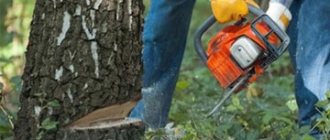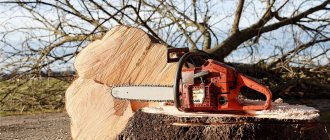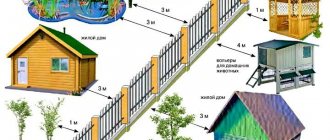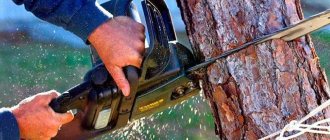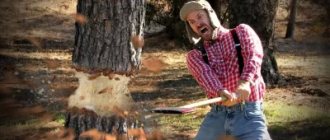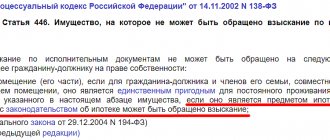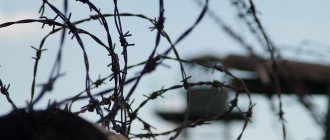A fairly common situation is when a tree needs to be cut down within a city. However, any person faces a fine for cutting down a tree in the city if the cutting was done illegally.
According to the law, tree cutting can only be done after obtaining a special permit. Even if you need to cut down a small bush near your house that is damaged and falls, you should get a felling ticket.
How to report a violator
Some citizens think that they have the right to cut down trees in the yard of their house, regardless of the opinions of other residents . Any felling of trees and woody plants is considered illegal unless a felling ticket has been issued for it by the landscaping department.
In addition, there is a rule of compensatory landscaping: for one tree cut down, two new ones are planted. They can be planted elsewhere and should grow.
Recently, some contracting organizations have been destroying trees without reason, having only an order from private individuals. Since they do not have permission from the residents of the house and from the city authorities, the organization can be fined up to 300 thousand rubles, depending on the amount of damage.
If trees or woody plants are cut down by an organization, you should contact the foreman and demand to show permitting documents . For each tree, he must have a cutting sheet, which indicates the type of tree, and the basis for cutting it.
Also, the team of workers must have an inspection report of green spaces, which must indicate tree species, the percentage of foliage and factors indicating the destruction of plantings.
If there is no special permission, it is considered illegal to cut down a tree in the local area . A person has the right to demand that work be stopped until the dispute is resolved.
If the team continues to work without permission, the police must be called. If they cannot provide the relevant documents to the police, they will have to stop working.
What can be done
If a person sees a tree that belongs to the city being cut down, he must record a violation of the law in a photo or video. The statement and such evidence of the offense should be addressed to the local police officer.
The application must indicate:
- your contact details (mobile phone number);
- a request to hold the offender accountable for unauthorized cutting;
- Full name of the offender and residential address (if known to the applicant);
- date, signature.
Evidence of guilt on a flash card is attached to the application.
Who to contact
Any tree felling automatically becomes illegal if it is carried out by persons who do not have the appropriate permit. Only certified arborists have the right to cut down emergency trees, as well as pruning and crowning, so your future contractor must have a license and documents confirming the admission of workers.
Our company has been working with trees for more than 10 years throughout the Moscow region and Moscow. Our work can be viewed on the website in the “portfolio” section. You can get prices for tree removal, calculation of the cost of additional services and free consultation on legal issues by simply calling us at: +7
Responsibility for illegal logging
Deforestation can lead to such harmful consequences as:
- soil erosion;
- increase in the amount of carbon compounds;
- climate change.
The government has established penalties for illegal destruction of trees. Any unauthorized felling is punishable by a fine.
Illegal logging means the destruction of part of the forest without the appropriate permit, which is issued by foresters or local governments after considering the need for cutting. Persons who commit a violation may be held accountable by environmental service officers, foresters or the police.
Regulatory documents
Responsibility for environmental violations is prescribed in Art. 260 of the Criminal Code of the Russian Federation, as well as in Art. 8.28 Code of Administrative Offenses of the Russian Federation . These documents apply to illegal logging without permission from the local administration.
In accordance with these articles, fines are imposed not for cutting down trees and bushes, but for lack of permission. According to Art. 261 of the Criminal Code of the Russian Federation, a fine is provided even if the tree was not cut down, but was damaged in some way and it stopped growing.
The severity of the punishment depends on:
- age;
- breeds;
- diameter;
- height.
The condition of the wood is determined by age - the younger the tree, the lower its specific value. The species affects the unit price of mature wood, and the diameter and height of the trunk are used to determine the volume.
Penalties
Any unauthorized logging without special permission is a violation of the law and faces penalties . The fine for unauthorized cutting down of trees for individuals and legal entities in 2021 is 3 - 4 rubles for individuals, in the case of a crime committed by organizations - 350,000 rubles.
If equipment was used that damaged the plantings, the amount of the fine increases to 5 thousand rubles, and the equipment and tools are confiscated.
Violator of Art. 260 of the Criminal Code of the Russian Federation expects a fine for a felled tree from 50 to 300 thousand rubles. For cutting down a large area, up to half a million rubles are charged.
If the responsible person committed a crime by taking advantage of his official position, he faces a fine of 1 million rubles . Causing particularly large damage entails payment of a penalty from 1 to 3 million rubles.
Administrative and criminal liability
Illegal digging of forest vegetation and causing damage threatens with an administrative violation, according to paragraph 29 of Art. 8 Code of Administrative Offenses of the Russian Federation. Unauthorized extraction and sale of timber is also considered a criminal activity.
The scale of the offense is classified into: significant, large and especially large. In accordance with each group, its own fine amount and type of punishment are assigned, which are determined by the court.
Demolition of trees without permission is considered an environmental crime . All trees, shrubs and vines without exception are considered objects of protection.
According to Art. No. 260 of the Criminal Code, punishment threatens not only for the destruction of part of the forest, but also for damaging the tree cover without the possibility of its restoration. The punishment will not be mitigated even for cutting down dead wood.
A fine is imposed even for demolishing a tree on your property if it borders a nature reserve or a zoo . Punishment can be imposed in the form of a fine and community service, and even threatens with criminal liability.
Other types of punishment
In addition to financial penalties, other types of sanctions may serve as punishment. The court may impose up to 450 hours of community service and imprisonment for up to 2 years.
If damage was caused on a large scale, then community service for up to 3 years, a fine in the form of earnings for 4 years, or imprisonment for up to 5 years are imposed.
If damage was caused on an especially large scale, then community service for up to 6 years, a fine in the form of earnings for 5 years, or imprisonment for up to 8 years are imposed.
Amounts of fines and types of punishments
| Amount of damage | Amount of fine without aggravating circumstances | Amount of fine taking into account aggravating circumstances | Other types of punishment not related to imprisonment | Deprivation of liberty |
| Minor |
|
| ||
| Significant | up to 500 thousand rubles. or a fine in the amount of salary for up to 3 years | A group of individuals – from 500 thousand to 1 million rubles or the amount of salary for 18-24 months. | up to 480 hours of community service; up to 2 years of correctional labor; from 100 to 200 thousand rubles or salary for 12-18 months. and up to 2 years of forced labor. | up to 2 years and a fine of 100 to 200 thousand rubles or in the amount of income for 12-18 months. |
| Large | from 500 thousand rubles. up to 1 million rubles or the amount of income for 18-24 months. | group of persons – from 1 to 3 million rubles or in the amount of income for 4-5 years; from 300 to 500 thousand rubles or the amount of salary for 2-3 years and up to 5 years of forced labor. | Up to 4 years and from 150 to 300 thousand rubles or in the amount of income for 18-24 months. | |
| Extra large | from 1 to 3 million rubles. or in the amount of income for 4-5 years | from 300 to 500 thousand rubles. or in the amount of salary for 2-3 years and up to 5 years of forced labor | up to 7 years and from 150 to 300 thousand rubles. or in the amount of income for 2-3 years |
Fine for deforestation in the city
Most city trees are the property of the local administration, as they are located on municipal land. Each unit is trimmed and whitened on time.
A dried out old tree is cut down to protect other plants from pests and diseases, and a sapling is planted in its place.
According to Art. 1064 of the Civil Code of the Russian Federation, damage caused to the municipality must be fully compensated . That is, in addition to the fine for illegal logging, it is necessary to reimburse all expenses to the municipality so that it can compensate for cutting down the plantings.
Municipal expenses:
- transportation of seedlings to the planting site;
- planting and growing;
- care until reaching the right age.
Also, a criminal case is initiated against those who cut down a tree on municipal land in accordance with Art. 167 of the Criminal Code of the Russian Federation.
In the forest
According to Federal Law N 77-FZ, citizens have the right to collect dead wood in the forest for their own needs . A person can find and cut down a dead tree, and cut it into small pieces before exporting it. However, local authorities were also given the right to establish prohibitions and restrictions.
If a person fails to prove that a felled tree is a dead tree, then he can be punished according to Art. 260 of the Criminal Code of the Russian Federation and Art. 8.28 Code of Administrative Offenses of the Russian Federation.
Depending on the volume of wood from the forest, the fine can range from 3 thousand rubles to 3 million rubles, and forced labor or imprisonment can also be imposed.
On a personal site
It is allowed to cut down or plant trees without permission only on your own plot of land, which belongs to the owner as a property.
There are people who cut down trees and shrubs near their plots, which border on protected areas, forests, nature reserves, and zoos. In this case, the fine for cutting down a tree can reach up to 50 thousand rubles.
Although Art. 209 of the Civil Code of the Russian Federation allows the owner to dispose of his property; cutting down trees on his land without permission falls under Art. 260 of the Criminal Code of the Russian Federation and 8.28 of the Code of Administrative Offenses of the Russian Federation . This applies to cases where a valuable plant is destroyed.
The problem is that the local administration is in charge of the list of valuable breeds, so the same breed, even in neighboring villages, can turn out to be either of little value or valuable.
In Moscow and the Moscow region, a felling ticket will be needed even if the tree grows on its own property, especially if it is oak or maple, which rarely grow in this area. Even if a citizen personally planted it on his plot, the tree belongs to the city’s green fund.
If the local administration finds out about the cutting of a valuable tree, the owner of the site will be issued a fine for cutting down a tree on his own site . Usually its size is 3-4 thousand rubles. If there are a lot of plantings, then the damage can reach 500 thousand rubles.
On someone else's property
If a tree was cut down on someone else’s property, then the amount of the fine is difficult to determine, since the owner allowed unauthorized felling, which means that responsibility is divided between him and the person who cut down the planting, according to Art. 32 of the Land Code of the Russian Federation.
If the owner of the land allowed the illegal cutting of trees on a summer cottage, then this is an aggravating circumstance, since a group of persons acted.
If he drank without his consent, then he will have to prove his innocence in court, which is quite problematic. If the owner of the plot informed the local administration or the police that illegal logging is taking place on his land, then he will not be considered an accomplice, especially if the violators were detained on the spot.
Who should cut down?
Despite the fact that the owner of the land is responsible for the emergency tree, he does not always have the opportunity to cut it down. After all, sawing is a complex multi-stage operation that requires special equipment and special skills.
Even in cases where a tree grows on municipal or federal land, the administration of a city, district or region cannot always provide qualified specialists. Therefore, in most cases this work is performed by various enterprises and private entrepreneurs.
We have prepared a brief overview of various situations related to the removal of emergency (dangerous) and nuisance trees, indicating those responsible for each stage of cutting or felling. It included:
- residents of private houses;
- residents of apartment buildings;
- owners of premises in apartment buildings;
- owners of premises in other buildings;
- tenants;
- land owners;
- employees of relevant departments of administrations at any level;
- employees of enterprises providing tree cutting or felling services.
Courtyards of private houses
Despite the fact that residents of private houses are also the owners of the plots on which they are located, responsibility for cutting down trees is distributed between them and the local administration.
After all, the owner of the site can arbitrarily remove only plants that are not subject to the Forest Code and other regulatory documents.
Moreover, the exact list of protected species, as well as the characteristics of trees whose unauthorized felling is prohibited, is established by the local administration, so they may differ in different cities and regions.
In addition, residents of private houses can independently remove only small trees growing on their territory, so to cut down a large plant they will have to contact the administration or those who provide such services, transferring responsibility for cutting down the trees to them. If the object grows on municipal land, which includes roads and sidewalks, then the local administration is responsible for it.
Neighbor's territory
There are situations when plantings on the territory of a neighboring site interfere with or create a danger. Then the question arises of how to force the neighbor to cut down the tree.
It is impossible to remove it yourself, because it is the property of the owner of the neighboring property, so cutting it down or cutting it down without permission causes damage and may result in litigation.
A tree that poses a serious danger cannot be removed without his consent, but in this case he is fully responsible for all damage caused by the dangerous object, so it will be easier to reach an agreement.
Adjacent territory of apartment buildings
Trees in the local area must be cut down by the person responsible for them. The management company (if the plant is located on public land) or the local administration is responsible for trees growing in the local area of apartment buildings.
A general meeting of residents can also initiate the cutting process, but to do this they will have to contact either the management company or directly to the contractor and trust them to prepare all the necessary documents.
The general meeting of residents or the management company can initiate cutting down in cases where a dangerous tree is located on municipal land, but poses a threat to people and objects on public territory.
City limits
In the city, the municipality is responsible for all issues related to the cutting down of trees, as well as the consequences of incorrect actions or inaction.
After all, it is at the city level that laws and regulations governing the control of green spaces are adopted.
This is caused by differences in climatic and other conditions, therefore the procedure for action, as well as the characteristics of trees covered by the Forest Code, may differ even in neighboring cities of the same Region or Region.
At the same time, any enterprise or resident who is disturbed or threatened by the plant can initiate felling or cutting down. However, an administration employee will still have to make a decision about the fate of the tree, taking into account all the facts, as well as be responsible for the decision.
If an administration employee does not see the threat, and the tree falls or otherwise causes damage, then both the employee and the administration, represented by its manager, will be responsible for this. They will also have to answer if, after cutting down or sawing down, it turns out that the tree was valuable and could have been preserved without interfering with the owner of the land in the implementation of his plans.
Legally obtaining permission
To cut down nuisance trees outside your own property, you must obtain permission to do so . Where to apply for permission? In Moscow, such a ticket can be obtained within 30 working days from the Department of Natural Resources.
First, you need to visit the local administration, where you need to notify employees of your intention to cut down a plant or tree, provide photos of the plantings, the surrounding area and documents for the site.
If the tree species turns out to be of low value, you will be given an official permit, after which the planting can be removed. If the tree species is valuable, then you will have to conduct an examination, pay for permission to cut down and carry out restoration measures.
However, one application for sawing will not be enough . First, an inspection is ordered and paid for, which indicates that the tree is indeed in disrepair, rotten or dry. Based on the determination of its condition, age and thickness, a conclusion is made. Compensation for landscaping is also calculated. The administration can also send a notification about the amount that should be transferred for the destruction of the tree.
To obtain a logging permit, you must provide:
- the address where the tree needs to be cut down;
- applicant's contacts;
- the number of plants on the territory to be cut down;
- foundation for demolition.
It will not be possible to obtain permission to remove historically important plantings that have cultural, scientific, unique or memorial significance. At most, they may only be allowed to cut down interfering branches.
It is possible to cut down a tree immediately on the basis of the act only if it poses a threat to the life and health of people, for example, it can fall at any moment or the branches rest against a window, which in a strong wind threatens an emergency.
In summary, illegal tree cutting is a serious offense that carries penalties including large fines, forced labor, or arrest. To ensure that the city authorities do not fine you for cutting down, you should familiarize yourself with the law in advance and follow the rules of cutting down.
Therefore, if green space bothers you, it is better to first get a permit, the payment of which is much less than the fine.
Who has the right to do this?
The Forestry Code of the Russian Federation allows both enterprises or entrepreneurs and individuals to cut down trees in the forest, but this must occur under the strict control of forestry workers.
After all, you cannot arbitrarily choose a tree that you want to cut down or cut down, because any removal of a plant should benefit the forest.
For this reason, only plants that have been marked by a forester can be cut down. In addition, you must first obtain a permit and pay a fee, which will be spent on restoring green spaces.
Therefore, cutting down trees in the forest can only be done by those who have received official permission and a felling ticket, which details the coordinates of the area where the trees to be cut down grow and the location of the plants to be cut down on the site. You will find additional information on all issues related to obtaining a permit in these articles:
- Permission to cut.
- Tree cutting.
- Why are trees cut down?
